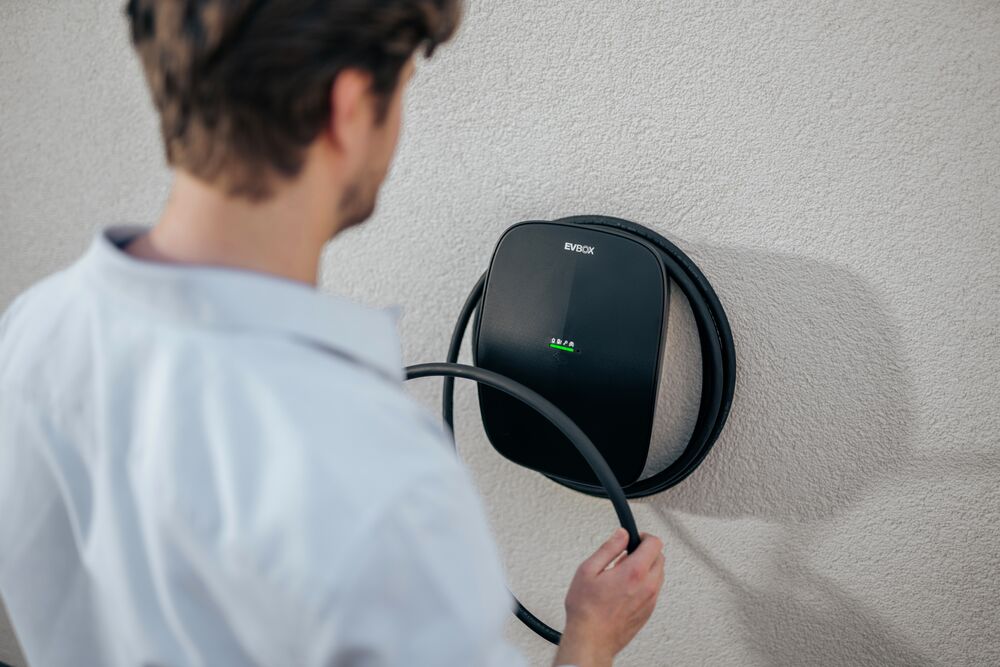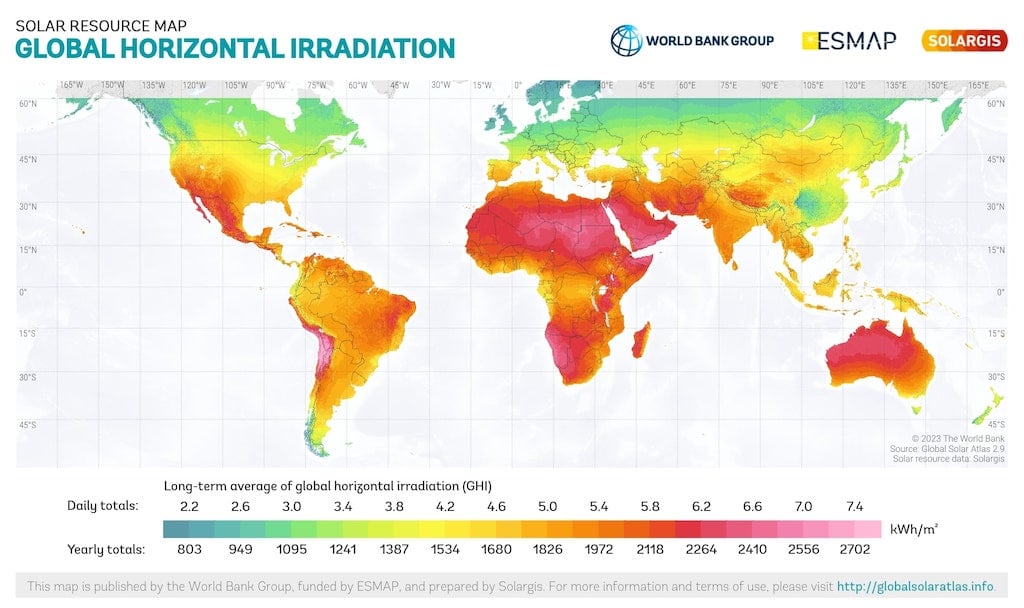
Taking a popular electric SUV, the Hyundai IONIQ 5 Long Range AWD, as our example vehicle, which has an energy consumption of 0.179kWh per km, covering the rough global average of 40km per day – be that to the office, the mall, or on the family school run – your EV would consume around 7.16kWh of electricity.
With standard 400W solar panels in a city that receives a worldwide average of 6 hours of sunlight per day, each solar panel would produce roughly 2.4kWh of electricity a day under ideal sunny conditions. Under cloudy conditions, this same solar panel may only produce 25% of this electricity or 0.6kWh of renewable electricity.
Thus, under sunny conditions, the Hyundai IONIQ 5 LR-AWD would require 3 x 400W panels to recharge its battery. Under cloudy conditions, 12 of the same panels would be required for the same charge.
Table of contents

The number of solar panels depends on your needs
The 100% free, clean, and infinite energy of the sun is something almost any homeowner anywhere in the world can access, provided they have the space to install a solar panel array. This energy can then be used to charge EV batteries, further lowering the EV driver’s carbon footprint as well as their utility bills. Naturally, however, different electric cars exert different demands on your home charging station, depending on a range of factors from their fuel economy to the average daily mileage their drivers cover.
This article is designed to help you calculate exactly how many solar panels you’ll need to install on your roof or at home in order to recharge your EV on a daily basis. We consider crucial mathematical factors such as the annual amount of sunlight your area receives, and the type of car and solar panels you own.
Naturally, your EV is not the only “device” drawing power in your household. But to keep this blog as clear and concise as possible, we’ll just focus on the net power you need to charge an electric car and how many solar panels you would need to do that.

Important factors that determine how many solar panels you need to charge your electric car
With the right solar setup, you can recharge the average EV using home-generated renewable electricity in just a few hours. A speedy solar charge time like this, however, requires a system optimized to your particular needs. We’ll now examine the four main factors influencing the charging potential of your solar panel array.
1) Electric car model, battery size, and energy efficiency
When it comes to calculating how many solar panels you need to charge an electric car, the first piece of the puzzle is the car itself. As with internal combustion engine (ICE) vehicles, every electric car is different – they have different battery capacities, different driving ranges on a full charge, and different energy consumption ratings: expressed as kWh/100km or kWh/100 miles, depending on where in the world you’re from.
Generally speaking, the bigger an EV’s battery, and the more energy it consumes per kWh, the more solar electricity the car will require to achieve the same relative recharge (for example, a recharge from 50-80%) when compared to a smaller, slower electric car. The more solar electricity required to recharge the car’s battery, the more solar panels you’ll need to install to meet your daily solar EV charging needs.
Below, we’ve listed a few different examples of popular modern EVs and their varying recharge requirements. We’ll use as a control a 60% battery recharge, from 20-80%.*
*We determine how much energy each vehicle would consume in depleting 60% of its charge (and thus how much energy a solar array would have to produce to replenish it) by using the following formula: (Capacity x 0.6) = “60%Consumption”. We then determine how many miles this energy consumption could cover using another formula:
(“60%Consumption” / Efficiency) = 60%Range.

EV charging requirement examples of popular models
Efficiency: 0.22kWh/km
Battery capacity: 95kWh
Range: 441km
The Audio e-tron 55 quattro would use 60% of its battery after driving around 259km. To recharge the battery used across this distance would require a solar panel output of about 57kWh.
Efficiency: 0.14kWh/km
Battery capacity: 42kWh
Range: 321km
The Fiat 500e Hatchback would use 60% of its battery after driving 180km. To recharge the battery used across this distance would require a solar panel output of about 25.2kWh.
Efficiency: 0.2kWh/km
Battery capacity: 98.7kWh
Range: 500km
The Ford Mustang Mach-E GT would use 60% of its battery after driving 296km. To recharge the battery used across this distance would require a solar panel output of about 59.22kWh.
Efficiency: 0.27kWh/km
Battery capacity: 75kWh
Range: 330km
The Toyota PROACE Verso L would use 60% of its battery after driving 167km. To recharge the battery used across this distance would require a solar panel output of about 45kWh.
Porsche Taycan Turbo S Sport Turismo
Efficiency: 0.23kWh/km
Battery capacity: 93.4kWh
Range: 458km
The Porsche Taycan Turbo S Sport Turismo would use 60% of its battery after driving 244km. To recharge the battery used across this distance would require a solar panel output of about 56.04kWh.
Efficiency: 0.17kWh/km
Battery capacity: 82kWh
Range: 496km
The Skoda Envaq iV 80x would use 60% of its battery after driving 289km. To recharge the battery used across this distance would require a solar panel output of about 49.2kWh.

Results
As you can see from the list above, recharging your EV a full 60% (from 20-80% battery) can require anywhere from 25kWh of solar-generated electricity to 60kWh. This amount of energy would also take you varying distances, from 296km in the Ford Mustang to just 167km in the Toyota PROACE. Evidently, the requirements placed on your solar EV charging array can differ greatly depending on your vehicle.
However, it is also worth noting that most of the time you won’t be relying on solar panels to charge your electric car from 20-80%. Instead, on an average day, most EV drivers use far less charge and thus would require a much smaller amount of solar-generated electricity to replenish their batteries. Hence the importance of the next factor: daily driving habits.
2) Daily driving habits
Few of us require a massive EV recharge on a day-to-day basis. Instead, the more likely solar EV charging scenario is that of the post-work top-up: replenishing the charge used on your commute to and from work, the grocery store, or on the family school run. For example, the average driver in the US covers around 60km per day, whilst in the EU that number can be as low as 12.41km per day. Referring back to the figures discussed above, it becomes clear that we’d need far less solar power to replenish the charge used covering these distances, and thus we’d need fewer home solar panels.

3) Solar panel power and efficiency
Another factor of importance to our calculations is the quality and efficiency of the solar panels installed in our home solar array. Some types of solar panels are better at converting sunlight to electricity than others, whilst higher quality panels tend to lose less of the electricity they generate during the supply process when compared to poorer quality panels. Next to this, the orientation of your solar panels can matter a great deal.
When shopping around for the best solar panels for your solar EV charging system, you’ll soon discover that there is a wealth of solar panel manufacturers to choose from, not to mention a diversity of solar panel types. From expensive high-efficiency monocrystalline panels to lower-efficiency, more affordable polycrystalline panels, and others.
Depending on your solar charging needs, you may find the more affordable panels meet your needs, or that you’ll need to stretch your budget a little further if you’re to meet your EV recharge requirements.
The two most important characteristics to consider when picking solar panels for your array are:
- Power rating: The wattage of the solar panel (the higher, the better)
- Typically, solar panels available today come in the 350-500+ watt range, with 400W being standard
- Efficiency: The percentage of potential solar energy a panel can capture and convert to electricity (the higher, the better)
- Solar panels typically only have efficiencies of around 15-20% on average, though the technology is improving all of the time and even 15% efficiency can translate into hundreds of watts of electricity

4) Average daily sunlight hours
Finally, you must also consider the amount of peak sunlight hours (and the strength of that sunlight) to which your solar EV charging array will be exposed.
In the northern hemisphere, especially in countries like the UK, Canada, parts of the EU and USA, Scandinavia, Russia, and East Asia, available sunlight is relatively scarce; whilst along the equator and for much of the southern hemisphere sunlight is comparatively abundant.
In the simplest terms, the less sunlight your house receives on an average daily basis, the more solar panels you will need to charge your electric car. The more sunlight your house receives, the fewer panels you will need to recharge an EV.
One of the key statistics to have to hand is GHI, or ‘global horizontal irradiation,’ meaning the average daily amount of sunlight irradiation your area receives, as expressed in kWh/m2. The other key statistic, which we’ll be focusing on in our calculations below, is the average daily number of sunlight hours your house receives.
This map from the Global Solar Atlas illustrate the massive variation in sunlight exposure and PV potential (in kWh) that different parts of the world receive.

Picture from Global Solar Atlas according to Creative Commons BY 4.0 license
Calculating your personal solar panel requirements and average daily energy consumption
To work out how many solar panels you need to recharge your electric car, you’ll first need to follow the formula below, substituting our example figures for those relative to your unique location, car, and solar panel power ratings and efficiencies.
The formula for calculating the daily energy consumption of your EV
To determine how much energy your electric car tends to use, first make a record of your average daily kilometers covered.
For example, we’ll use the rough halfway point between the daily kilometers covered by American and European drivers: 40km/day.
Next, multiply this figure by the energy efficiency of your specific electric car. As an example, we’ll use that of the popular Hyundai IONIQ 5 Long Range AWD, which is 0.18kWh/km.
In our example, a Hyundai IONI 5 LR-AWD covering 40km at an average efficiency of 0.18kWh/km would use 7.2kWh of electricity. This figure will be key when determining the number of solar panels required to recharge your EV.

The formula for calculating the potential energy output of your future solar panel array
Next, you need to calculate how much energy a solar panel array could produce on average, per day, in your location. For this, you’ll need to know the wattage of your preferred solar panels and the average peak sunlight hours in your area.
 We’ll take a 400W monocrystalline solar panel as standard and use two different examples of average sunlight hours from around the world – one high and one low. California, in the USA, receives 3,055 hours of sunlight annually, or (divided by 365 days) 8 hours of sunlight daily. In contrast, London, in the United Kingdom receives just 1526 hours of annual sunlight, or 4 hours of daily sunlight.
We’ll take a 400W monocrystalline solar panel as standard and use two different examples of average sunlight hours from around the world – one high and one low. California, in the USA, receives 3,055 hours of sunlight annually, or (divided by 365 days) 8 hours of sunlight daily. In contrast, London, in the United Kingdom receives just 1526 hours of annual sunlight, or 4 hours of daily sunlight.

To determine how many kWh a 400W solar panel would produce in these locations, we first multiply the wattage by the daylight hours, then divide the resultant watt-hours by 1,000 to give us the kilowatt hours.
(Average daily sunlight hours x Solar panel wattage) = (Watt-hours per day) / 1,000 = Kilowatt-hours per day
California
(8 x 400) / 1,000 = 3,200 Wh / 1,000 = 3.2kWh
London
(4 x 400) / 1,000 = 1,600Wh / 1,000 = 1.6 kWh
Results
You can see there is a vast difference between the potential energy production of the exact same solar panel positioned in one part of the world versus another. You would need to almost double the number of solar panels in London to produce the same amount of electricity compared to California, USA.
The formula for calculating how many solar panels you need to charge your electric car
With the calculations above complete, and your location-, panel-, usage- and car-specific figures to hand, we can now calculate exactly how many solar panels you’ll need to recharge your EV on an average daily basis.
For the purposes of demonstration, we’ll use our Hyundai IONIQ 5 LR-AWD and our California/London example.
The calculation is simple. Just divide the number of kWh your vehicle consumes on an average daily basis (as calculated above) by the number of kWh of electricity one of your solar panels can produce according to the average sunlight in your area. Finally, round that number up to the nearest whole to give you the total number of panels you’ll require. The formula looks like this:
(Average daily EV energy consumption / Average daily solar panel output) = Number of panels required
California
7.2kWh / 3.2kWh = 2.25 panels = 3 panels
London
7.2kWh / 1.6kWh = 4.5 panels = 5 panels
Results
In California, USA, you’d need 3 x 400W panels to recharge your Hyundai IONIQ 5 LR-AWD following the average daily commute of 40km. In London, UK, however, you’d need to install 5 of the same 400W panels to achieve the same recharge.

Battery storage considerations
By complementing your solar EV charging setup with a battery storage system, you can potentially reduce the number of solar panels you require to recharge your vehicle. By storing all of the electricity your panels produce in batteries, you can recharge your EV at any time of day or night (i.e., even when your panels are not producing electricity).
Given that some days you may not use your EV at all, and on others you may use it to cover only a few kilometers rather than your daily average, you may find that your PV array produces a surplus of electricity, thus reducing the number of panels required to recharge your car.
Example calculations from around the world: How many solar panels do you need to charge an EV?
The below table comprises a number of different vehicles and different solar setups located in different parts of the world. The hope is that this table will give you a clearer idea of the widely varying number of solar panels required to recharge an EV following the average daily commute of 40km.
|
Car type |
Average daily energy consumption (based on 40km commute) |
Location |
Average daily sunlight hours |
Solar panel power rating |
Average daily panel output |
Number of panels required to recharge EV |
|
Audi e-tron 55 quattro |
8.8kWh |
6.9 hours |
300W |
2.07kWh |
5 panels |
|
|
Fiat 500e Hatchback |
5.6kWh |
4.6 hours |
350W |
1.6 kWh |
4 panels |
|
|
Ford Mustang Mach-E GT |
8.0kWh |
4.23 hours |
400W |
1.69kWh |
5 panels |
|
|
Toyota PROACE Verso L |
10.8kWh |
4.6 hours |
450W |
2,07 kWh |
6 panels |
|
|
Porsche Taycan Turbo S Sport Turismo |
9.2kWh |
4.5 hours |
500W |
2.25kWh |
5 panels |
|
|
Skoda Enyaq iV 80x |
6.8kWh |
6.9 hours |
550W |
3.80kWh |
2 panels |
Bear in mind that these panel requirement estimations are based on solar panels being installed and functioning at peak efficiency. The actual efficiencies of panels will differ according to GHI, temperature, shading, and panel maintenance, among a range of other factors. On cloudy days, solar panels may produce as little as 25% of their peak output. As such, it is generally worth considering the installation of additional panels for recharging your electric car as a contingency measure.

In terms of EV charging, are solar panels worth it?
Charging your car with your solar panels can be a great way to charge your car for free with 100% renewable energy.
Importantly, though, you must first determine how many solar panels you need to charge your specific electric car, considering factors such as your daily energy consumption and the strength of sunlight in your area.
Using the formula devised, you can paint a clear picture of exactly how many solar panels to install in your home EV-charging array. Not only will this save you time and hassle in the long run, but it can also help to reduce costs overall.
Under peak conditions, most home solar EV charging setups would require between 3 and 7 solar panels. However, given the variability of sunlight, cloud cover, and energy needs of other appliances, it is generally worth installing additional panels as a contingency measure.
Related articles

Smart Charging for Solar EV Systems: What is possible today?
There are a variety of smart solutions available, capable of optimizing your solar EV charging system in different...

Can solar EV charging save you money?
Charging your EV using household solar panels can indeed save you money on your utility bills. How much money solar EV...

How to optimize your solar set-up for charging electric cars at home
There are several ways EV drivers can optimize a homegrown solar system to ensure their EV recharging needs are met....